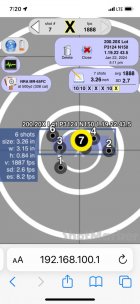I approach things just a little bit differently, I suspect. In the first place, if the action is crooked so that the bor of the bridge is misaligned with the bore of the receiver ring (in other words, if the bore of the receiver is bent), I choose to ignore everything except the bridge and the ring. I turn a mandrel which about .695 in diameter, except for a bulge which will be located in the center of the receiver bridge. This bulge is turned to be semi-spherical and will have a diameter of about .702 (or whatever it takes to fit the bore snugly). At the receiver ring, at the top of the locking lug abutments, there is a similar bulge which fits tight at this location. So, with the mandrel in place, there is no contact except at these two points, and the mandrel follows a straight line between the middle of the receiver bridge and the rear of the receiver ring. Is this clear?
Now, I put my jig (a piece of heavy walled steel tubing with some brass tipped set screws in it) on the receiver. Before I put the jig on, I slide a sleeve, about 1/4 inch thick, over the receiver. This sleeve helps to prevent distortion of the receiver when I tighten up the set screws. I set the whole out fit between centers and dial in the fixture to where it is running true in all respects. Now, I remove mandrel and set the fixture up in the four jaw chuck and the steady rest so that it runs true. Then it is a simple matter to recut the threads and locking lug abutments. When I'm finished, I have a receiver which has threads which are aligned with a straight line from the middle of the receiver bridge to the rear of the receiver ring, and locking lug seats which are perpendicular to this same line. The bolt, of course, flops around just as it always has so that is the next step. I cut a pair of dovetails, .0625 deep, in the bolt body, at 6 and 12 oclock, located at the middle of the receiver bridge. I install the dovetail inserts and turn them to fit the bore with minimal clearance. At the front of the bolt I have the option of (a) doing nothing, (b) installing inserts right behind the locking lugs, or (c) locating the front of the bolt by the use of a teflon o-ring in the barrel counterbore.
I don't like the idea of cutting a dovetail right behind the lugs because the corner of the cut might produce a stress point and weaken the lug. For this reason, I will use plugs, soft soldered in place, instead. To be honest, I really kind of prefer the teflon o-ring system or the do nothing approach. If the bolt is aligned at the bridge and if the perfectly machined locking lugs are seated against their perfectly machined seats, the bolt must be aligned. I haven't gone into the machining which is done to the bolt (apart from the inserts) because it is so simple that no explanation is necessary. Any misalignment of the bore of the bridge with the bore of the ring is immaterial because I have established my own line, from which everything else is generated.
Anyway, I hope my description is understandable. I'm working on some You Tube videos but have learned that I am a much better gunsmith than I am a videographer, and I'm not that much of a gunsmith. I have a way to go to even achieve rank amateur production quality! WH











